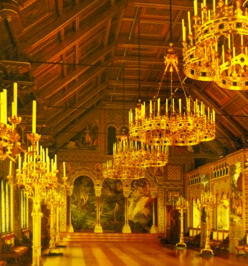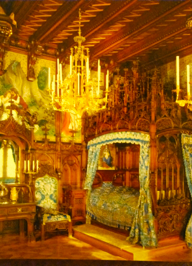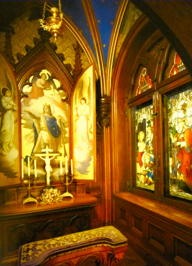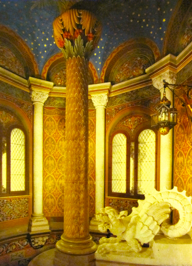neuschwanstein castle interior
schwangau
Bavaria, GERMANY
europe
March 7, 2011


neuschwanstein castle interior
schwangau
Bavaria, GERMANY
europe
March 7, 2011


A tour of Neuschwanstein Castle was fascinating. This was the project of King Ludwig II, who reigned as king after the death of his father in 1864 until June 12, 1886, when he was declared legally insane. The castle is in the style of late Romanesque period of the 13th century. The paintings ornamenting the interior illustrate the king’s favorite operas composed by Richard Wagner.
The rooms we visited included:
•The Red Corridor
•The Entrance Hall of the Fourth Floor is divided into two aisles. Groin vaults adorned with decorative paintings. Floor tiles are from Mettlach. To the left, under the double windows, are the servants’ quarters.
•The Throne Hall measures approximately 15 meters/45 feet high and 20 meters/60 feet long. It was deisnged in an elaborate Byzantine styule by Eduard Ille and Julius Hofmann. Inspired by the Hagia Sophia in Constantinople (now Istanbul) the 2-story Throne room with its series of pillars of imitation porphyry and lapis lazuli, was completed the year of the king’s death, 1886. Set in half-domed, golden alcove, the throne platform is approached by a flight of white marble steps. The throne itself, designed in gold and ivory, was never fabricated. The platform is flanked by paintings of the Twelve Apostles, and behin the platform is a pattern of golden lions, the symbol of Bavaria.
•The Dining Room of carved oak is decorated with paintings by Ferdinand von Piloty and Josef Aigner. They present figures from the “Minnesinger” period and scenes from the Wartburg astle at the time of the legendary Song Contest in 1207. Over the door to the right is Wolfram von Eschenbach, the author of “Parzival” and “Lohengrin”. The interior design of the room is by Julius Hofmann. The table sculpture, over one meter high, shows Siegfried fighting the dragon, a gift from Munich artists to Ludwig II.
•The Bedroom. In contrast to the other room, the bedroom is carved in Neo-Gothic style. Fourteen woodcarvers worked 4 1/2 years to create this room. The monarch’s bed is covered with richly embroidered draperies. The wall paintings illustrate the “Tristan and Isolde” story, a story which, in Wagner’s operatic realization, had deeply impressed the 20 year old king. A stream above the castle brough fresh water directly to the basin in the washstand.
•The Private Chapel. Adjoining the bedroom is the small Chapel, dedicated to the patron saint of the king -- Louis IX of France, St. Louis. The richly carved winged altar is set into the decorated wall. The altar paintings show scenes from the life of St. Louis. The stained glass windows to the right show St. Louis receiving the last sacraments. The windows are the work of “Mayerischen” Court Art Studio.
•The Dressing Room is completed in relatively simple oak paneling. The trellis-work painted on the ceiling gives the impression of the room being open to the sky. The wall paintings illustrate the life and work of Walther von der Vogelweide and Hans Sachs, after the “Siegfried” motives of the Entrance Hall, and the “Tristan” motives of the bedroom. This room is given over to the world of the “Meistersinger” period.
•The Living Room and the swan’s corner. The richly decorated Living Room with its etension chamber, the so-called “Swan’s Corner”, is completelly dedicated to the legend of the Swan Knight Lohengrin, a saga of great meaning and importance for Ludwig II. The large murals by Hauschild and von Heckel depict “The Miriacle of the Grail” and the Arrival of Lohengrin in Antwerp”. The motif, carved and painted on the ceilings and in the golden needle-point of the silk upholstery and draperies. Ludwig II, who as a young prince was overwhelmed by Wagner’s opera Lohengrin that he considered it a form of enlightenment, identified himself wholly with the Swan Knight and enjoyed dressing up as Lohengrin. The tragedy of Lohengrin was his essential loneliness. This was also the fate of the King.
•The Grotto and the Winter Garden Between the Living Room and the Study, Ludwig II had an artificial stalactite cavern built. These were in romantic vogue at the time. The landscape sculptor Dirrigl from Munch, who had also built the grotto in the park of Schloss Linderhof, built this grotto out of oakum and plaster-of-Paris, which has an artificial waterfall and which, with its illumination from above, is very effective. As one goes out of the grotto, immediately to the right after the Living room, one comes to the entrance of the Winter Garden closed off by a glass door sunk into the rock. The fountain in the Winter Garden was originally intended for the second floor. Thereit was to have graced a Moorish Hall modeled on the Alhambra in Granada. When the king died, the work on the castle ceased and the fountain was placed in the Winter Garden. As in Wagner’s opera “Tannhäuser”, the grotto was to have represented the introduction to the study, in whih room the painting of the legend is have to been seen.
•The King’s Study The Gothic-styled Study of the king is stamped with references to history of the Wartburg Castle. The paintings, set in finely carved wall panels, are carried out on Gobelin canvas by Josef Aigner and illustrate the Tannhäuser saga and the Song Contest of the Warburg.
•The Adjutant’s Chamber
•The top of the Stairway
•The Entrance Hall to the 5th Floor
•The Gallery to the Singer’s Hall
•The Singer’s Hall, designed by architect Julius Hofmann, was inspired by both the banquet hall and the singer’s hall of Warburg Castle. The Singer’s Hall occupies the entire 4th floor of the castle and is a copy of the minstrels Hall of Warburg Castle in Thuringia, designed by Julius Hofmann. The murals in the hall and in the corridor depict scenes from the “Parzival” saga of the middle-ages, which were, to a certant extent, incorporated by Wagner in his sacred festival-drama, Parsifal. Neuschwanstein Castle, create by Ludwig as a Grail Castle and simultaneously a Castle of the Swan Knight Lohengrin, embraces yet another hero in this hall, namely Tahnnhäuser.
•The Kitchen, completely in;tact, shows how modern technology was allowed to take its place within the atmosphere of the middle ages captured in the upper stories. The elaorate equipment includes hot an cold running water, and automatic spit roasters.
After Ludwig II’s unexpected death, his family cancelled all contracts and uncompleted orders placed with suppliers. All work on the castle ceased.
PHOTOS: Left Column: 1. Detail: The Throne Hall, where King Ludwig II wanted to pay homage to the idea of royalty as bestowed by the grace of God. The throne, designed but never built, was to have been placed at the top of the white marble stairs in the apse designed to resemble a Byzantine church. The missing throne underscores the incongruity between Ludwig II’s exalted idea of a sacrosanct monarchy and the political climate of the time. 2. View of the Throne Hall. The balcony has Byzantine arches with concrete columns painted to resemble lapis lazuli. 3. Top of the stairway reserved exclusively for the king when he was in residence. Center, Top: The swan’s corner of the Living Room. Center, Middle: The large backdrop on the stage of the Singer’s Hall. The painting represents Klingsor’s magic garden in Wagner’s Parsifal saga. Center, Bottom: The Singer’s Hall, one of the most important rooms of the castle. The paintings in the hall illustrate Wagner’s Parsifal saga. Right Column: 1. Portrait of the King Ludwig II of Bavaria. 2. The king’s private chapel. 3. The Bedroom of the king, designed in the late Gothic style.

Honoring the Music of Wagner








